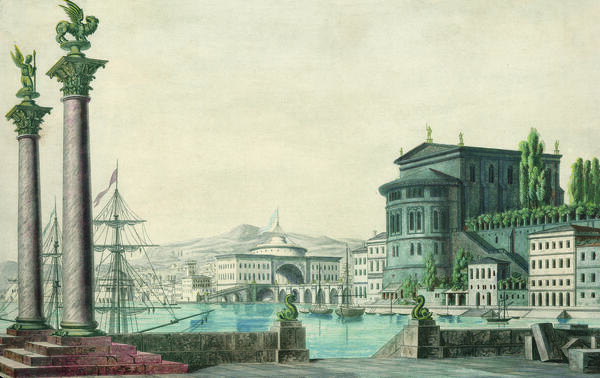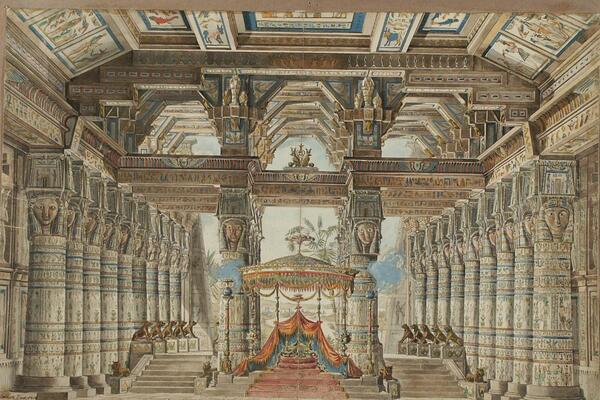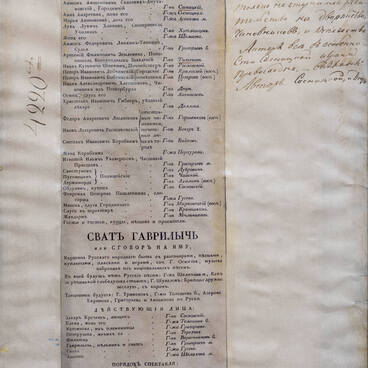Andreas Leonhard Roller was born in 1805 in the city of Regensburg, Bavaria, into a family of theater workers: his father was a stage setter, his uncle was a concertmaster, and his mother was a singer. Following in his father’s footsteps, Roller studied at the Academy of Fine Arts and the Polytechnic Institute in Vienna. The future painter of perspective and theatrical scenery also studied carpentry, which was indispensable in his profession. In 1822, Roller started to work as a stage setter in theaters of Vienna, Munich, Dresden, and Berlin.
Caesar in Egypt
Время создания
1834
Место создания
Russia
Размер
50,5x73,2 cm
Техника
paper, ink, watercolor
Коллекция
Выставка
7
Открыть в приложении#7
#13
Andreas Roller. Set design for the opera “Oberon” by Carl Maria von Weber. 1872
#14
In 1834, Andreas Roller was invited to work in Russia. By that time, he was already a well-known scene painter, an experienced stage designer, and a great stage setter. According to the contract signed with the Directorate of the Imperial Theaters, Roller was obliged “to arrange stage sets in the Imperial Saint Petersburg theaters, as well as in theaters as far as thirty miles outside the city, in the best way possible.”
#15
Andreas Roller. Set design for the opera “Otello” by Gioachino Rossini. 1853
#17
Andreas Roller. Set design for the ballet “Caesar in Egypt.” 1834
#18
In Russia, Andreas Roller adopted the name Andrey Adamovich. His first project in the new capacity of a Saint Petersburg scene painter was the ballet “Caesar in Egypt” by the Italian composer Gaspare Spontini. For the first time in Russia, Roller introduced moving scenery — the banks of the Nile were “moving”, creating the illusion of a river flow. This production earned Andrey Adamovich a diamond ring from Emperor Nicholas I.
Throughout his career in Russia of nearly forty years, Andreas Roller designed scenery and arranged mechanisms for more than 200 productions, including the premieres of Mikhail Glinka’s operas “A Life for the Tsar” and “Ruslan and Lyudmila” in Saint Petersburg, as well as many ballets by Marius Petipa.
Given his experience as an engineer, Roller was invited to take part in the reconstruction of the Saint Petersburg Imperial Bolshoi Kamenny Theater and the Winter Palace, as well as do repairs to the stage and mechanisms in the Hermitage Theater. Roller also painted several front curtains and created a panorama of the city of Palermo.
In 1839, Roller became a member of the Academy of Arts and later founded and headed a class in perspective scenery. After building a brilliant career and living in Russia for many years, Andreas Roller received Russian citizenship in 1873.
Throughout his career in Russia of nearly forty years, Andreas Roller designed scenery and arranged mechanisms for more than 200 productions, including the premieres of Mikhail Glinka’s operas “A Life for the Tsar” and “Ruslan and Lyudmila” in Saint Petersburg, as well as many ballets by Marius Petipa.
Given his experience as an engineer, Roller was invited to take part in the reconstruction of the Saint Petersburg Imperial Bolshoi Kamenny Theater and the Winter Palace, as well as do repairs to the stage and mechanisms in the Hermitage Theater. Roller also painted several front curtains and created a panorama of the city of Palermo.
In 1839, Roller became a member of the Academy of Arts and later founded and headed a class in perspective scenery. After building a brilliant career and living in Russia for many years, Andreas Roller received Russian citizenship in 1873.
#12
Ministry of Culture of the Russian Federation
читать дальшескрыть
00:00
00:00
1x
Caesar in Egypt
Время создания
1834
Место создания
Russia
Размер
50,5x73,2 cm
Техника
paper, ink, watercolor
Коллекция
Выставка
7
Открыть в приложении
Поделиться






